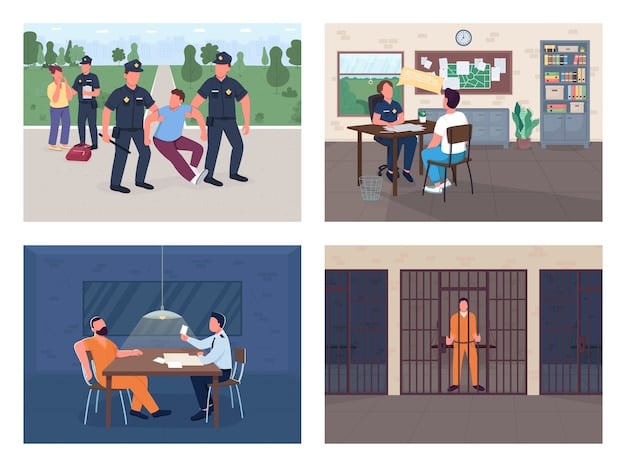Community Policing Impact: Lower Crime Rates Nationwide?

Community policing initiatives aim to reduce crime rates across the nation through collaborative partnerships between law enforcement and the communities they serve, fostering trust and addressing local crime issues proactively.
Are community policing initiatives truly changing crime rates across the nation? This approach focuses on building trust and collaboration between law enforcement and the communities they serve. Let’s explore the impact of these initiatives on crime prevention in the US.
Understanding Community Policing Initiatives
Community policing initiatives represent a fundamental shift in law enforcement strategy. Rather than simply reacting to crime, community policing focuses on proactively addressing the root causes of crime and building strong relationships between police officers and the community.
This approach acknowledges that effective crime prevention requires a collaborative effort. It emphasizes open communication, mutual respect, and shared responsibility between law enforcement and residents.
Key Principles of Community Policing
Community policing is guided by several core principles that distinguish it from traditional law enforcement models.
- Partnership: Collaboration between police and community members to identify and address local crime problems.
- Problem-Solving: Proactive analysis of crime trends and implementation of targeted strategies to prevent crime.
- Community Engagement: Regular interaction between police officers and community members to build trust and understanding.
- Accountability: Transparency and responsiveness of law enforcement agencies to the needs and concerns of the community.
Benefits of Community Policing
The implementation of community policing strategies can yield a range of benefits for both law enforcement and the community. These can include:
- Reduced crime rates through targeted crime prevention strategies.
- Improved police-community relations and increased trust.
- Enhanced community safety and security through collaborative problem-solving.
- Greater community involvement in crime prevention efforts.
In conclusion, community policing initiatives are designed to foster a collaborative environment where law enforcement and the community work together to address crime. This proactive, partnership-based approach aims to create safer and more secure communities.

The Impact of Community Policing on Crime Rates
One of the primary goals of community policing initiatives is to reduce crime rates. By fostering trust and collaboration, law enforcement agencies can effectively address the underlying causes of crime and implement targeted prevention strategies.
Numerous studies have examined the impact of community policing on crime rates, with many demonstrating positive results. These studies highlight the effectiveness of proactive, community-based approaches to crime prevention.
Research Findings on Crime Reduction
Research on the impact of community policing initiatives on crime rates has yielded compelling evidence of their effectiveness.
- A 2019 study published in the Journal of Experimental Criminology found that community policing strategies were associated with a significant reduction in violent crime rates in urban areas.
- A 2020 report by the National Institute of Justice concluded that community policing programs were effective in reducing property crime and improving community satisfaction with law enforcement.
- A meta-analysis of 50 studies on community policing found that these initiatives were consistently associated with lower crime rates across a range of communities.
Case Studies of Successful Initiatives
Several communities across the nation have implemented successful community policing programs that have led to significant reductions in crime rates. Some notable examples include:
The city of Seattle implemented a community policing program that focused on building relationships between police officers and residents in high-crime neighborhoods. The program resulted in a 20% decrease in violent crime rates in targeted areas.
In Boston, community policing initiatives have been credited with reducing youth violence and gang activity. The city’s success is attributed to its focus on collaborative problem-solving and community engagement.
Ultimately, the evidence suggests that community policing initiatives can be an effective tool for reducing crime rates and improving community safety. By fostering trust and collaboration, law enforcement can address the root causes of crime and implement targeted prevention strategies. That ultimately protect neighborhoods.
Building Trust and Improving Police-Community Relations
A crucial component of any successful community policing initiative is building trust and improving relations between law enforcement and the community. Without trust, it is difficult to effectively address crime and create a sense of shared responsibility for community safety.
Trust-building efforts can take many forms, including community meetings, neighborhood events, and joint problem-solving initiatives. The goal is to create opportunities for police officers and community members to interact in positive and meaningful ways.
Strategies for Building Trust
There are several effective strategies for building trust between law enforcement and the community.
- Community Forums: Organize regular community forums where residents can voice their concerns and ask questions of police officers.
- Neighborhood Events: Participate in neighborhood events and festivals to interact with community members in a relaxed and informal setting.
- Youth Outreach Programs: Implement youth outreach programs to build relationships with young people and promote positive interactions with law enforcement.
- Cultural Sensitivity Training: Provide cultural sensitivity training to police officers to help them better understand and respect the diverse communities they serve.
The Role of Transparency and Accountability
Transparency and accountability are essential for building and maintaining trust between law enforcement and the community. Law enforcement agencies must be open and honest about their policies, procedures, and actions.
In addition to transparency, law enforcement agencies must hold themselves accountable for their actions. This includes investigating complaints of misconduct and taking appropriate disciplinary action when necessary.
In summary, trust and improved relations between law enforcement are vital for the success of community policing initiatives. By employing strategies that build mutual trust and accountability, communities can take important strides toward creating safer, more secure environments for everyone.
Addressing Specific Crime Problems Through Community Policing
Community policing initiatives are particularly effective when they are tailored to address specific crime problems within a community. By conducting thorough assessments of local crime trends and patterns, law enforcement agencies can develop targeted strategies to prevent and address crime.
These could address issues such as, drug trafficking, gang violence, or property crime. The key is to identify the specific challenges facing a community and develop solutions that are tailored to its unique needs.
Targeted Crime Prevention Strategies
Community policing enables the creation of targeted crime prevention strategies customized to address local concerns. Methods include:
- Hot Spot Policing: Focusing resources on areas with high crime rates to deter criminal activity.
- Problem-Oriented Policing: Analyzing the underlying causes of crime problems and developing solutions tailored to specific situations.
- Community Crime Watch Programs: Engaging residents in crime prevention efforts through neighborhood watch programs and community patrols.
- Restorative Justice Practices: Using restorative justice practices to address crime and repair harm to victims and communities.
Collaborative Problem-Solving
Collaborative problem-solving is a key feature of community policing. It involves law enforcement, community members, and other stakeholders working together to identify and address crime problems.
Bringing a diversity of experience to the table enables richer solutions that are more appropriate. Collaborative problem-solving can lead to more effective and sustainable solutions to crime problems. It also builds trust and strengthens relationships between law enforcement and the community.
Successful community policing initiatives directly address and adapt to the distinct crime-related issues in a locale. Law enforcement entities can formulate specific, preventative plans by thoroughly assessing the prevailing crime styles and movements. This guarantees resources are aimed accurately offering the greatest consequences in curbing, solving the issues.

The Role of Technology in Community Policing
Technology could play a significant role in enhancing community policing initiatives, helping to improve communication, data analysis, and crime prevention efforts. Law enforcement agencies can leverage technology to connect better with communities, gather intelligence, and deploy resources more effectively.
Social media, crime mapping software, and body-worn cameras are just a few examples of the technologies that can be used to support community policing. However, it is important to use technology in a way that is consistent with community policing principles, such as transparency, accountability, and respect for privacy.
Leveraging Technology for Communication and Engagement
Modern tech offers unprecedented opportunities for law enforcement to connect with their communities. Digital tools empower community policing, enabling better interaction, data exchange, and preventative measures.
- Social Media Platforms: Utilize Facebook, Twitter, and Instagram to share information, engage in conversations, and solicit feedback from community members.
- Mobile Apps: Develop mobile apps that allow residents to report crimes, provide tips, and access community resources.
- Online Crime Mapping Tools: Use online crime mapping tools to provide residents with real-time information on crime trends and patterns in their neighborhoods.
- Virtual Community Meetings: Host virtual community meetings to reach residents who may not be able to attend in-person meetings.
Addressing Concerns About Privacy and Surveillance
Law enforcement agencies must be mindful of privacy concerns when using technology for community policing. It is essential to have clear policies and procedures in place to protect privacy and prevent the misuse of technology.
Technology can revolutionize community policing, providing law implementation with tools that improve communication, insight, enhance crime avoidance strategies. To realize potential, entities should tactfully integrate tech, making sure privacy isn’t compromised by maintaining openness while fostering trust within communities.
Challenges and Obstacles to Community Policing
While community policing initiatives hold great promise for reducing crime and improving police-community relations, they are not without their challenges and obstacles. Implementing and sustaining community policing programs can be difficult, particularly in communities with a history of mistrust and strained relations between law enforcement and residents.
Budget constraints, staffing shortages, and lack of training can also hinder the effectiveness of community policing programs. Additionally, some police officers may resist the shift from traditional law enforcement models to a more community-oriented approach.
Overcoming Resistance to Change
One of the biggest challenges to implementing community policing is overcoming resistance to change within law enforcement agencies. Some officers may be uncomfortable with the idea of working closely with community members or may not see the value in community policing strategies.
To the effectiveness of community policing initiatives, dealing with resistance is crucial not just inside law enforcement but in general throughout the neighborhoods as well. Getting past these difficulties entails tactics such as:
- Providing Training and Education: Providing officers with training and education on community policing principles and best practices.
- Involving Officers in the Planning Process: Involving officers in the planning and implementation of community policing programs to gain their buy-in and support.
- Recognizing and Rewarding Success: Recognizing and rewarding officers who are successful in implementing community policing strategies.
Securing Funding and Resources
Sufficient funding and resources are essential for sustaining community policing programs. However, many law enforcement agencies struggle to secure the necessary funding to support these initiatives.
To successfully manage community policing initiatives effectively, secure funding is vital, often posing a substantial hurdle for law enforcement agencies. Navigating financial challenges entails several approaches, such as:
- Pursuing federal, state, and local grants to support community policing programs.
- Collaborating with community organizations and businesses to secure funding and resources.
- Prioritizing community policing in agency budget allocations.
In conclusion, although community policing offers tremendous potentials, a lot of issues could surface particularly regarding adoption, funds also community participation. Overcoming these hurdles requires committed leadership, clear strategies, moreover constant assessment to realize a benefit in these ventures.
| Key Point | Brief Description |
|---|---|
| 🤝 Partnership Building | Fostering collaboration between police and community members. |
| 📉 Crime Reduction Strategies | Implementing targeted initiatives to lower crime rates. |
| 📢 Community Engagement | Encouraging active participation in local safety initiatives. |
| 📱 Technology Integration | Using technology to improve community connection and crime prevention. |
Frequently Asked Questions
Community policing initiatives are strategies that promote collaboration between law enforcement and community members to address crime and improve public safety.
By fostering trust and collaboration, community policing allows law enforcement to better understand and address the underlying causes of crime in a community.
Technology can enhance communication, data analysis, and crime prevention efforts, helping law enforcement connect with communities and deploy resources more effectively.
Challenges include resistance to change within law enforcement, budget constraints, staffing shortages, and the need for ongoing training and education.
Communities can support these initiatives by participating in community meetings, volunteering in crime prevention programs, and fostering positive relationships with law enforcement.
Conclusion
Community policing initiatives represent a transformative approach to crime prevention, emphasizing collaboration, trust, and problem-solving. While challenges exist, the evidence suggests that community policing can be an effective tool for reducing crime rates and improving police-community relations across the nation when implemented thoughtfully and consistently.





